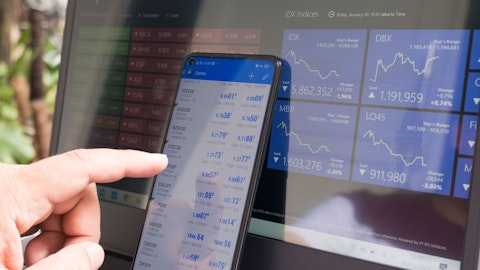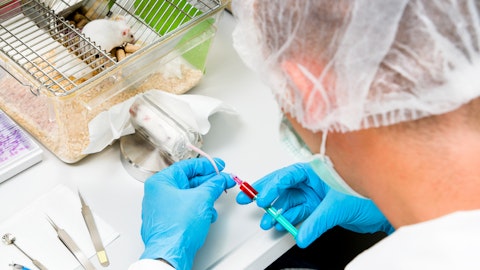VistaGen Therapeutics, Inc. (NASDAQ:VTGN) Q2 2024 Earnings Call Transcript November 10, 2023
Operator: Good day, everyone and welcome to today’s Vistagen Fiscal Year 2024 Second Quarter Corporate Update Conference Call. [Operator Instructions] Please note this call is being recorded. I will be standing by if you should need any assistance. It is now my pleasure to turn the conference over to Mark McPartland. Please go ahead sir.
Mark McPartland: Thank you, Travis. Good afternoon, everyone and welcome to Vistagen’s fiscal year 2024 second quarter corporate update conference call and webcast. This afternoon we filed our quarterly report and issued a press release providing an overview of our progress last quarter. We encourage you to review the release, which can be found on the Investors section of the Vistagen website. During today’s call, we will make forward-looking statements regarding our business based on our current expectations and information. Forward-looking statements speak only as of today and except as required by law, we do not assume any duty to update in the future any forward-looking statement made today. Of course forward-looking statements involve risks and uncertainties and our actual results could differ materially from those anticipated by any forward-looking statements we make today.
Additional information concerning risks factors that could affect our business and financial results is included in our fiscal year 2024 second quarter Form 10-Q for the period ending September 30, 2023, and in future filings that we will make with the SEC from time to time, all of which are or will be available on our website and the SEC’s website. With that taken care of I’d like to thank and welcome all of our stockholders, analysts and everyone taking an interest in Vistagen. I’m joined on the call today by Shawn Singh, our Chief Executive Officer; Cindy Anderson, our Chief Financial Officer; and Josh Prince, our Chief Operating Officer. Shawn will provide an overview on the recent results and our progress across our key pipeline programs.
A brief opportunity for questions from our sell-side analysts will follow the prepared remarks. This call is being webcast and will be available for replay after completion. The replay link can be found in the Investor Events section of our website. I would now like to turn the call over to our Chief Executive Officer, Shawn Singh.
Shawn Singh: Thank you, Mark and good afternoon, everyone and thank you for joining our call. We achieved several milestones since our last call to establish a well-defined and fully funded Phase 3 development program of our lead pherine asset fasedienol with the potential to enable us to advance to appeal to a potential NDA submission for the acute treatment with social anxiety disorder. In the midst of the ongoing mental illness crisis, we are poised to transform the treatment paradigm for this widespread anxiety disorder that affects the lives of about 10% of our population. Social anxiety disorder or SAD is a disruptive, serious and potentially life-threatening anxiety disorder with high opportunity cost in daily life and no FDA approved patient tailored, as needed acute treatment option to help individuals rapidly and safely, address their anxiety when the stresses are upon them during what for many is their decades long journey with SAD.
The hope of a revolutionary approach to treatment extends beyond fasedienol and SAD to our full pherine-based-portfolio and we remain fully focused on their development to create faster-acting, safer alternatives to address significant unmet needs in large CNS-related markets, where current treatment options fall short for patients. Since our last conference call in August, we’ve continued to build on the momentum created by our successful PALISADE-2, Phase 3 study of fasedienol for the treatment of anxiety in adults with social anxiety disorder. During the past few months, we’ve strengthened our balance sheet considerably, securing $137.7 million in gross proceeds from equity financings and exclusive negotiation agreement with Fuji Pharma regarding a potential license to develop and commercialize our PH80 in Japan.
We expect this cash infusion will extend our corporate runway through several important clinical and corporate milestones as we advance our pipeline including our primary focus on a potential US new drug application or NDA for fasedienol in SAD. Given that fasedienol’s rapid onset mechanism of action is differentiated from all FDA approved anxiety drugs. Our primary target initial indication for fasedienol remains the acute treatment of anxiety in adults with SAD. And as noted, there’s no FDA approved drug therapy for the acute treatment of SAD. For that acute indication, we’ve previously aligned with the FDA that a simulated public speaking challenge in a clinical setting is an appropriate study design and that the subjective units of distress scale or SUDS is an appropriate primary efficacy endpoint to assess the efficacy of fasedienol because it provides a measure of anxiety on a minute by minute basis immediately related to specific stressor and we believe utilizing a simulated anxiety provoking public speaking challenge study design provides the most appropriate and efficient path for fasedienol to potentially become the first FDA approved acute treatment of anxiety for adults with SAD.
So to complement the positive top line results from PALISADE-2, we are currently preparing to launch two similar Phase 3 clinical trials in 2024: PALISADE-3 in the first half of 2024 and PALISADE-4 in the second half of 2024. Like the successful PALISADE-2 study both PALISADE -3 and PALISADE-4 will be multicenter randomized double-blind placebo-controlled Phase 3 clinical trials, designed to evaluate the efficacy, safety and tolerability of the acute administration of fasedienol to relieve anxiety symptoms in adult patients with SAD after a single dose of fasedienol during a simulated anxiety provoking public speaking challenge conducted in the clinical setting and as measured using the patient reported SUDS as the primary efficacy endpoint.
PALISADE-3 and 4 will also have an open label extension for up to 12 months to provide additional long-term safety data. If successful, we believe either PALISADE-3 or PALISADE-4, together with PALISADE-2, may establish substantial evidence of the effectiveness of fasedienol in support of a potential fasedienol NDA submission for the acute treatment of anxiety in adults with SAD in the first half of 2026. We also plan to initiate a small fasedienol Phase 2b repeat dose study in the second half of 2024. The fasedienol repeat dose study will be a multicenter randomized double-blind placebo-controlled clinical trial a small one about 60 subjects to evaluate the efficacy safety and tolerability of a repeat dose of fasedienol that’s administered 10 minutes after an initial dose to further relieve symptoms of acute anxiety in adults with SAD during the anxiety provoking public speaking challenge.
That repeat dose study will consist of three different dosing arms with an open label extension for up to 12 months. 12 months open label extensions planned for the PALISADE-3, 4 and repeat dose studies are all intended to expand our fasedienol safety database. For ICH guidelines targeting 300 patients treated with fasedienol for at least six months and 100 for 12 months. To-date, over 750 subjects, have been exposed to fasedienol including over 30,000 doses administered in our PALISADE open label safety study. And we continue to be very encouraged with fasedienol safety profile in all clinical studies to-date. Positive PALISADE-2 data also bolster our growing confidence in the evidence supporting the potential of our entire pherine pipeline.
We’ve had some recent advancements in a couple of other programs. Let’s take a brief look at those. In June, we completed a successful randomized double-blind placebo controlled Phase 1 study, intended to investigate the safety and tolerability of itruvone in healthy adult subjects. That trial was conducted to stage potential Phase 2b clinical development of itruvone in the US and it confirmed the favorable safety profile by itruvone, establishing three previous clinical trials conducted in Mexico, including a positive randomized double-blind placebo-controlled Phase 2a study of itruvone in major depressive disorder or MDD. As we advance and remain focused primarily on our PALISADE Phase 3 program for fasedienol in SAD, we also plan to explore various ways to unlock the significant potential value by itruvone as a differentiated non-systemic monotherapy for MDD through potential strategic partnering arrangements in the US as well as in major markets outside the US.

A team of scientists in lab coats surrounded by pharmaceuticals and medical equipment, researching a life-saving oncology-focused biotechnology.
We’re also optimistic about our hormone-free non-systemic PH80 nasal spray, which has now been studied in multiple significant women’s health indications. Within the last two quarters, we’ve announced positive results from two PH80 studies in women’s health indications. The first of which was the exploratory Phase 2a study of PH80 in women diagnosed with vasomotor symptoms or hot flashes that are due to menopause. And the Phase 2a study PH80 induced a significant reduction in the daily number of hot flashes compared to placebo at the end of the first week of treatment and the improvement was maintained through each treatment week until the end of the treatment period. PH80 treatment also significantly reduced the severity of the disruption and function sweating related to hot flashes during the treatment period compared to placebo.
It was well tolerated with no serious adverse events and the adverse event profiles were comparable between PH80 and placebo. One of the favorable aspects of running additional trials in this particular indication is that there will be objective measures for these studies that say that it’s easier to measure how many hot flashes are experienced in the frequency of those symptoms versus more subjective end points that we often see in other studies in different indications. The other positive PH80 data we announced recently were from an exploratory Phase 2a study of PH80 for the acute management of premenstrual dysphoric disorder or PMDD. In this study, PH80 demonstrated statistically and clinically significant improvement versus placebo in symptoms of PMDD using the subject rated Penn daily symptom report as early as day four continuing to day six.
There are limited effective treatment options that help with both physical and mood symptoms of PMDD and we believe these results are quite promising. Given the depth of our entire CNS pipeline and the now robust body of successful safety and efficacy studies to date, we are also pursuing multiple potential nondilutive strategic development and commercialization partnerships, both global and regional to unlock the full value of our product candidate portfolio efficiently. We believe global and regional partnerships would amplify our internal expertise and development activities, potentially accelerate key development time lines and enhance our overall efforts to deliver differentiated new treatment options where the current standard of care fall short.
As an example of this, we recently announced the receipt of $1.5 million from our exclusive negotiation agreement with Fuji Pharma, regarding a potential license to develop and commercialize PH80 in hot flashes due to menopause and other indications in Japan. This is simply a right to discuss the potential for that license with us in a time-limited period. It’s not a license. It’s simply a nonrefundable payment to us to talk to us. I will now turn the call over to our new CFO, Cindy Anderson to summarize some of the highlights from our financial results for our fiscal year 2024 second quarter. Cindy has been a great recent addition to our team, following the retirement of our former CFO, Jerry Dotson after his over 10 years of distinguished service to the company.
Cindy?
Cindy Anderson: Thank you, Shawn. It’s great to be part of team. As Shawn mentioned, I’d like to highlight a few financial results for fiscal year 2024 second quarter. I also encourage everyone to review our quarterly report on Form 10-Q filed with the SEC earlier this afternoon for additional details and disclosures. Research and development expenses decreased by approximately $9 million from $12 million to $3.9 million for the quarter ended September 30, 2022 and 2023 respectively. The decrease in R&D expense, primarily due to the completing the initial studies of our PALISADE Phase 3 programs in SAD, as well as reduced non clinical development regulatory and outsource manufacturing activities for fasedienol and itruvone. Selling and administrative expenses decreased by approximately $0.5 million from $3.7 million for the quarter ended September 30, 2022 to $3.2 million for the quarter ended September 30, 2023, primarily due to decreased compensation, consulting fees and professional services.
Our net loss attributed to common stockholders for the quarter ended September 30, 2023 was approximately $6.6 million versus a net loss of approximately $17.5 million for the quarter ended September 30, 2022. At September 30, 2023, Vistagen had cash and cash equivalents of approximately $37.6 million. From September 30, we received approximately $93.5 million in net proceeds from an underwritten equity financing and $1.5 million from Fuji Pharma under exclusive negotiation agreements. If our PALISADE Phase three program is successful, w believe that our current cash position will be sufficient to fund our operations through potential submission of a US new drug application for fasedienol for the acute treatment of anxiety in adults with SAD.
As a reminder, please refer to our quarterly report on Form 10-Q filed today with the SEC for additional details and disclosures. I will now turn the call back over to Shawn.
Shawn Singh: Thank you, Cindy. So to wrap up, our dedication to enhancing global mental health and the overall well-being of individuals who are affected by a wide range of CNS disorders is unwavering. And as we are progressing through the next phases of our corporate development strategy, we’re doing that with confidence in the potential of our PALISADE Phase 3 program for fasedienol in social anxiety disorder, as well as the clinical stage assets that are up and down our entire pipeline. We’ve got a capable team, got a robust pipeline and we’ve got a steadfast commitment to pioneer and differentiated solutions, totally different approaches to the current standard of care for multiple sizable CNS markets that have substantial unmet needs.
So on behalf of our entire Vistagen team, once again, we’re grateful for the privilege and for the opportunity to create meaningful impacts for patients not only in the US, but all around the world, who are impacted in their daily lives by these disruptive and often disabling serious CNS conditions.
Mark McPartland: Thank you, Shawn. Operator, we’d like to open up the call for questions from the sell-side analysts participating on the call today.
See also Stocks On the Rise: 12 Best Stocks To Buy and 11 Best Restaurant Stocks To Buy.
Q&A Session
Follow Vistagen Therapeutics Inc. (NASDAQ:VTGN)
Follow Vistagen Therapeutics Inc. (NASDAQ:VTGN)
Receive real-time insider trading and news alerts
Operator: Yes, sir. [Operator Instructions] Our first question comes from Andrew Tsai, Jefferies.
Andrew Tsai: Hey good afternoon. I appreciate taking the questions and congrats on the progress. Great to see you making strides here. So, obviously the next step for — PH94B is to start the PALISADE-3 in first half of 2024. So, what needs to be done for you to start earlier in Q1, rather than Q2? What exactly are the bottlenecks there next? Thanks.
Shawn Singh: Thanks, Andrew. Appreciate the question. I agree, thanks to INN, it is easy to say PH94B than fasedienol. We hope the world will get used to that soon enough. The answer is we are targeting Q1 and so we are — everything we’re doing right now is in preparation to launch PALISADE-3 in the first quarter of 2024. So all the pregame work a lot of that’s already been underway for several months now. And of course we bring a lot of knowledge from the prior studies to bear into that effort. So that’s our target and we’d expect to be able to have PALISADE-4 follow hopefully early in the second quarter — early in the second half of 2024.
Andrew Tsai: Okay. Very good. And can you summarize for us just one more time, all the things you’re going to do differently and PALISADEs 3 and 4 to ensure study execution, what removal/deletions or additions are you making to these studies relative to the prior two studies?
Shawn Singh: Yeah, great. Thank you for that question. It’s important question. As you obviously know the macro world is fundamentally different as we move into the first part of 2024 as it is right now relative to 2022 or 2021, certainly 2021. And what’s nice to see is the return to normal of a lot of the typical conventions that are associated with efficient execution, preparation and execution of clinical studies. As it relates to our particular protocol and the studies that we’ll be initiating going forward with this public speaking challenge in the study design that’s associated with SUDS, there are certain things that may or may not have been in effect, but we know that it’s possible for COVID to disrupt the olfactory system a bit.
So there will be no subjects enrolled that have had a nasal swab within a month for RSV, for COVID, for flu. They’ll have to pass the smell test an olfactory — clinical factory test in order to be eligible, to be no high-frequency vapors or smokers or drinkers of Red Bull and things of that nature. There’s a high level of scrutiny that’s associated with the front end with assessing patient eligibility, Josh Prince is on. Josh is our COO and oversees our team. Josh, you want to highlight a few other things?
Josh Prince: Yeah. I think you captured a couple there Shawn. And it’s important to think of essentially we’re doing everything we can to ensure that we have the patience for this one-dose public speaking challenge make sure you have patients in there that can get the benefit from product. It’s those things that Shawn mentioned that’s also kind of do the oversight in terms of sites, in terms of changing the way that we monitor and work with our CRO over the sites to make sure that we’re on top of things that we have data reviews, eligibility reviews those types of things. So those are the key is to make sure that we have a successful study. It’s really all about the execution of that public speaking challenge with the right patients in there and that’s where we’re focused forward.
Shawn Singh : Some of the other things Andrew that are possible. Obviously, the surveillance is — it’s fundamentally changed since even PALISADE-2. So part of our operating model is to make sure we have our own people on sites in addition to the resources that are brought to bear by CROs in the sites themselves. Of course, no masks will be involved in PALISADE-3 or PALISADE-4 which is a big difference from the prior studies. So just trying to get back to a situation where the macro environment allows us to apply, a lot of the trade craft that’s been historically successful when we’re trying to not only plan for, let’s say with an in-person investigators’ meeting the likes of which weren’t possible with some of the earlier studies.




